
In July, I made a wedding cake for my friend Clare and her now-husband Tony. I’ve known Clare for most of my life – we first met in grade 1, and we shared the unique experience of having parents who were teachers and/or principals in a small town, thereby ensuring that most of our friends had been either taught social studies, ukulele, French and/or given detention by our mum or dad. We were in French immersion together from grade 7 onward, and I have a vivid memory of dressing as the Spice Girls with a group of friends for one of her epic birthday parties (I, slightly unconvincingly, was Scary Spice). We sort of lost touch after high school when we both moved away to university and started Adult Life, but I was totally thrilled when Clare told me she was getting married and asked if I would make her cake. Obviously, I said yes!
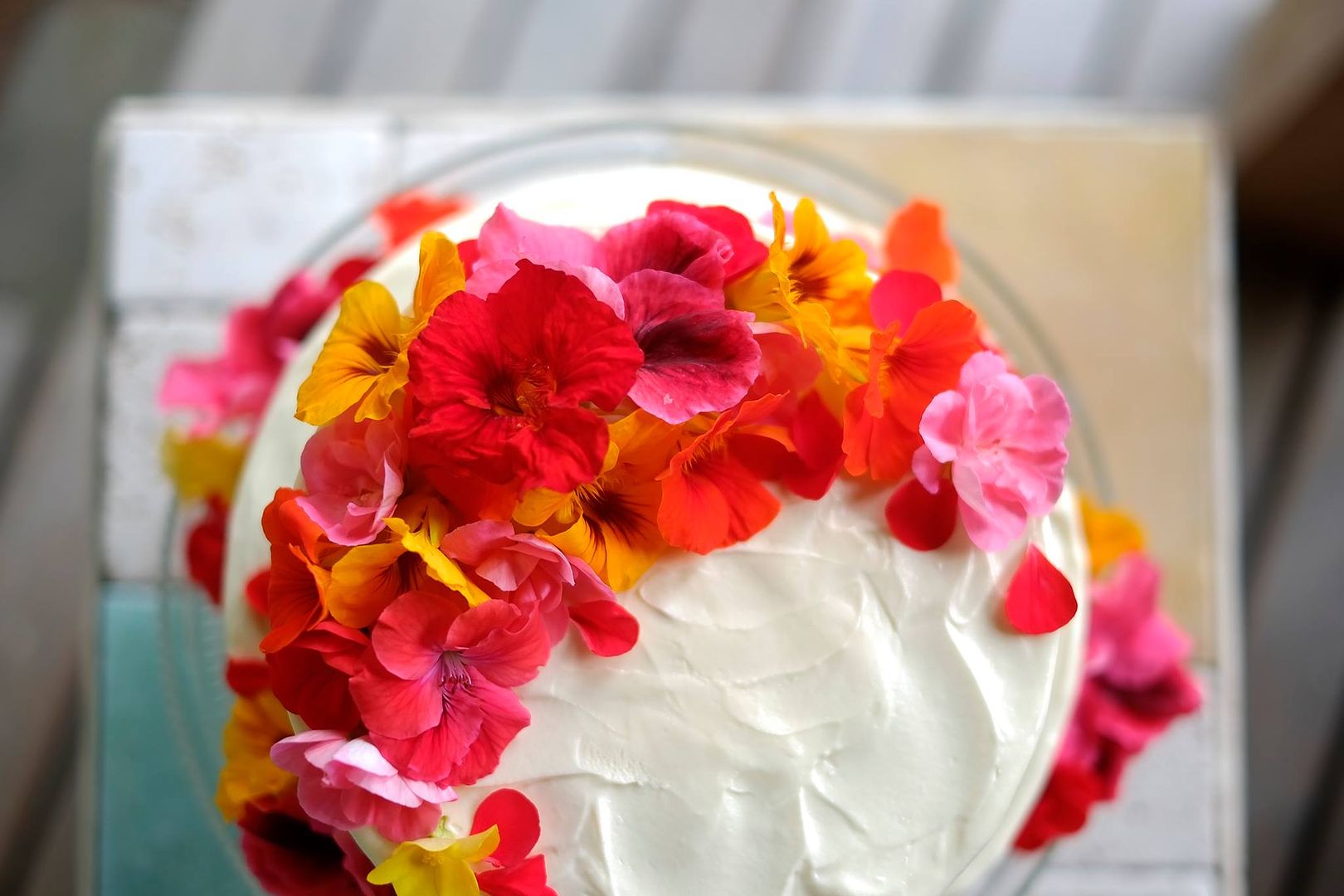
Clare and Tony requested a carrot cake (hence the previous carrot cake research), and since their fairly non-traditional wedding was taking place in a field on Salt Spring Island, they wanted their cake rustic and naked. In case you’ve been living under a rock with no wifi, naked cakes are THE thing right now, and they consist of a layer cake with either very little or no frosting around the sides, so that the cake layers themselves are visible. Not only can they be very pretty and elegantly rustic, they are dead easy to achieve from a decoration standpoint. They tend to come in varying degrees of nudity, from totally nude with frosting only between the layers, to semi-nude with enough frosting spread around the sides to smooth out any gaps between the visible cake layers, to partially clothed with just a glimpse here and there of the cake layers peeking out from under the frosting. Clare’s preference was for the semi-nude version, which I think looked really nice with the white frosting providing a dramatic contrast against the dark carrot cake.
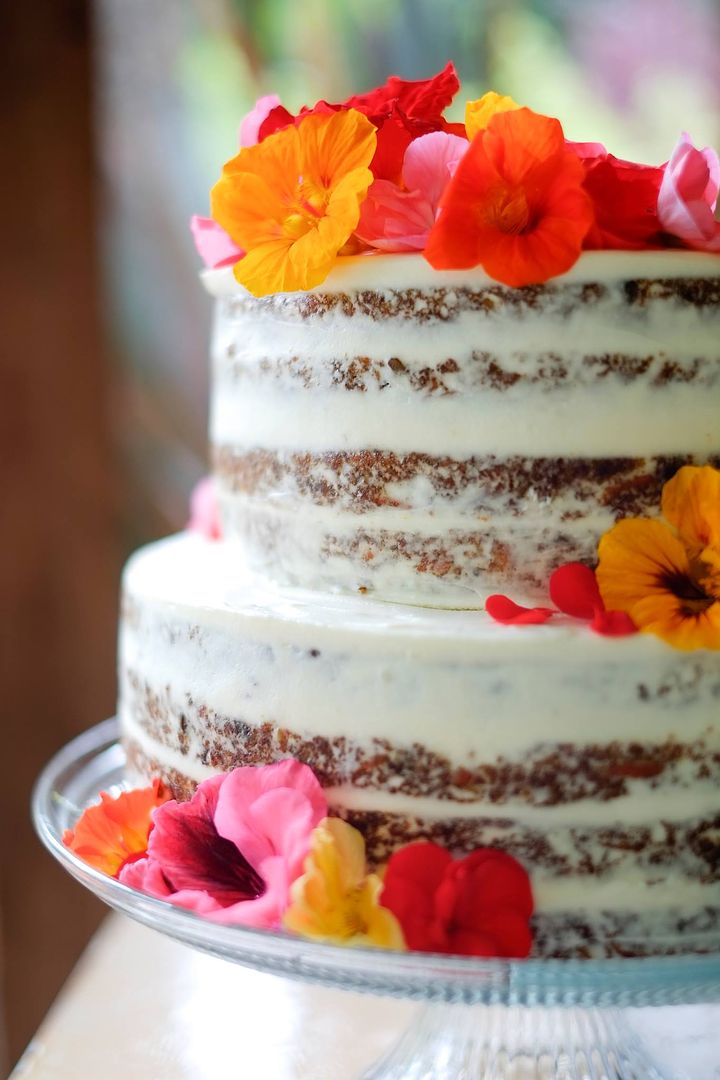
Carrot cake needs cream cheese frosting, and I decided to tackle my old nemesis, cream cheese Swiss meringue buttercream, one more time for good measure. I used Sweetapolita’s Swiss meringue buttercream recipe and then mixed it with 75% cream cheese by weight, which resulted in a fairly soft but oh-so-delicious frosting. I added some melted white chocolate because I figured it would help stabilize the frosting, and also, YUM. The softness of the frosting was fine here because there was no fancy piping, however if you have plans to do more elaborate frosting decorations, I recommend using about 50% cream cheese instead to get a firmer, more pipeable result. I used the fantastic rebar carrot cake recipe for the cake layers, which is chock-full of nuts and coconut and pineapple and very moist and delicate, so I’d highly suggest slicing, filling, and frosting the cake while it is partially frozen to keep it from falling apart on you.
I’m super pleased with the way the cake turned out, and the groom had three pieces, so I think it was a hit. 🙂 Congratulations Clare and Tony!
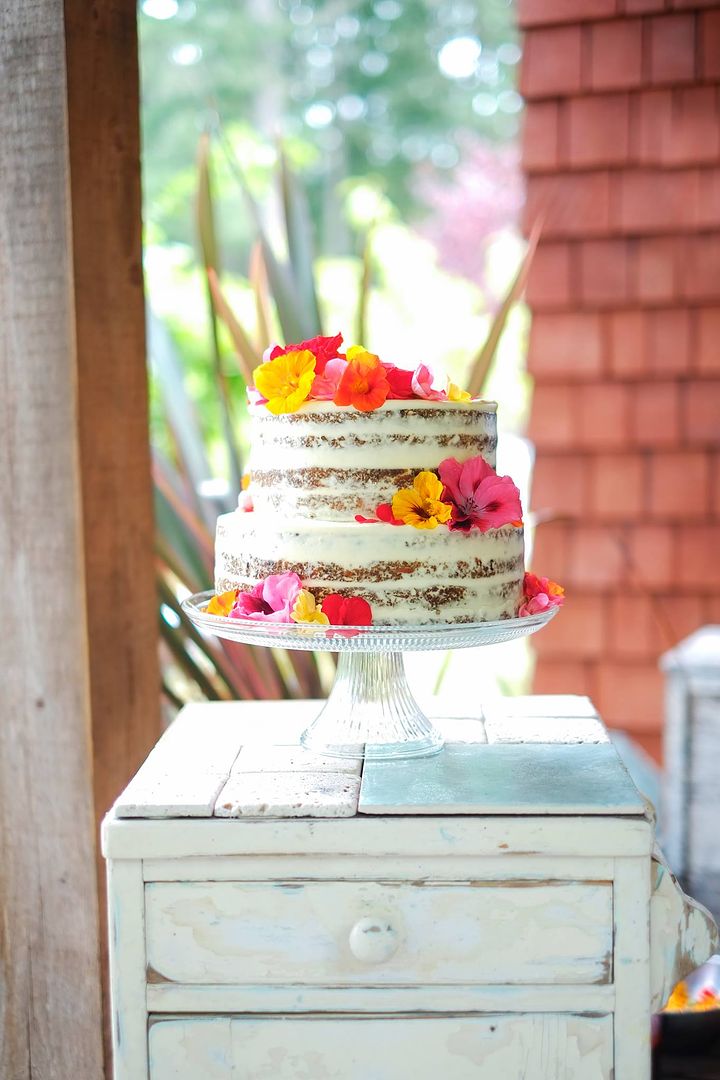
The four photos above are by Emma Allen of Emma Allen Photography and Design – thanks for the gorgeous pics Emma! <3
{Naked} Carrot Wedding Cake
I’ve already posted about most of the techniques and formulas used in this cake, so rather than repeat myself, I’m just going to provide links and an explanation where appropriate. The formulas below are for an 8″ and 10″ two-tiered cake, making about 60 servings. I used this cake chart to calculate the servings.
Carrot Cake Layers
Recipe: Rebar Carrot-Coconut Cake (or try this one if you prefer your carrot cake with less “stuff” – this cake is also a little less delicate for stacking)
- For the 8″ tier: make recipe as written and divide evenly between 2 x 8″ round cake pans (about 770 g batter in each pan)
- For the 10″ tier: make 1 1/2 times the recipe and divide evenly between 2 x 10″ round cake pans (about 1180 g batter in each pan)
Butter your pans and line them with parchment paper. Before baking, wrap a strip of wet towel around the outside of each pan to help insulate the cake while it bakes for a perfectly even, level cake. Both size cakes took 25-30 minutes in the oven.
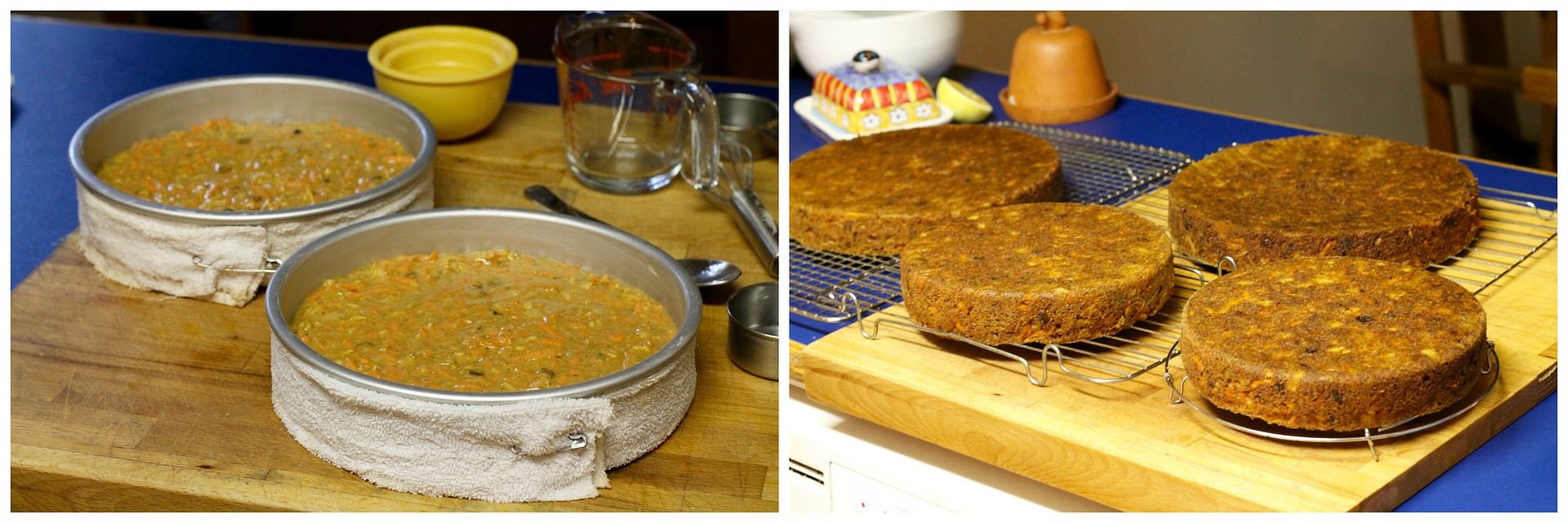
Cool the cakes completely on a rack, then wrap tightly in plastic wrap and foil and freeze for up to several weeks. Because the Rebar cake is fairly moist and delicate, I suggest having it partially frozen for decorating, so even if you’re not baking it way ahead of time, do freeze it!
White Chocolate Cream Cheese Swiss Meringue Frosting
I estimated that I would need about 10 cups of frosting total to fill and frost the cake – in real life, it worked out to slightly less: I used about 1/2 cup between each layer and on the top and sides of the 8″ cake, and about 1 cup between each layer, top, and sides for the 10″ cake. Whatever the math was, I ended up with just the right amount of frosting! I used the frosting/filling amounts in this post to come up with my estimates.
The method for cream cheese Swiss meringue buttercream is to mix the buttercream into whipped cream cheese, at a ratio of 50-75% cream cheese by weight. I did some complicated volume to weight conversions to come up with how much buttercream plus cream cheese I’d need to get about 10 cups, and ended up with these amounts: 1000 g Swiss meringue buttercream to 750 g cream cheese. This resulted is a fairly soft frosting – if you want it to be a little firmer for piping, use only 500 g cream cheese. Or try this frosting instead.
Recipe: Sweetapolita’s Swiss meringue buttercream
Make 2/3rds of the recipe as written to get about 1000 g of buttercream, using these ingredient amounts:
- 200 g egg whites (I used pasteurized from a carton)
- 335 g sugar
- 450 g unsalted butter
- 15 ml vanilla
- pinch salt
Once you’ve made the buttercream, beat in 300 g melted, cooled white chocolate.

Whip 500-750 g cream cheese until light (don’t over-do it or it will get runny). Add in the Swiss meringue buttercream a scoop at a time and mix until combined – it should be creamy yet fluffy.

Assembly
Here’s where you get to crumb coat the cake and call it decorated! Seriously, naked cakes are great 🙂 This is how I made a semi-nude cake – use more or less frosting to achieve the nudity level you prefer.
Slice each cake layer in half horizontally – this is much easier to do if the cake is partially frozen. Place the bottom layer on a cardboard cake round that is trimmed just slightly smaller than the cake itself (this is important – there is not enough frosting to hide the cake board if it sticks out beyond the cake) and place the whole thing on a rotating decorator’s stand. Spread each layer with frosting and top with the next layer of cake – you’ll need about 1/2 cup frosting between each 8″ layer, and about 1 cup between each 10″ layer. Spread the frosting right to the edge and don’t worry if it squishes out around the sides a bit. Once you’ve got all the layers stacked, spread the top with a thin layer of frosting and spread the sides with the existing frosting that squished out between the layers, filling in any gaps. Chill for 15-20 minutes to set the frosting.

To make sure the sides are straight and gap-free, place a dollop of frosting on top of the cake and spread it out, letting it fall over the sides. Spread an even layer of frosting around the sides to fill in any gaps between the layers, then hold your spatula straight up and down against the side of the cake, angled slightly in towards the cake, and rotate the cake stand to scrape away the excess frosting to reveal the cake layers.
Follow the instructions in this video to make the top level, then swirl the frosting as desired. Chill the cake for several hours before stacking.

To stack, you’ll need to put dowel supports in the bottom tier – see this post for instructions. Because there was no decorative piping around the base of the second tier, I cut the support dowels slightly below the level of the frosting, and then I scraped away some of the frosting underneath where the second tier would rest so that there was no gap between the tiers.
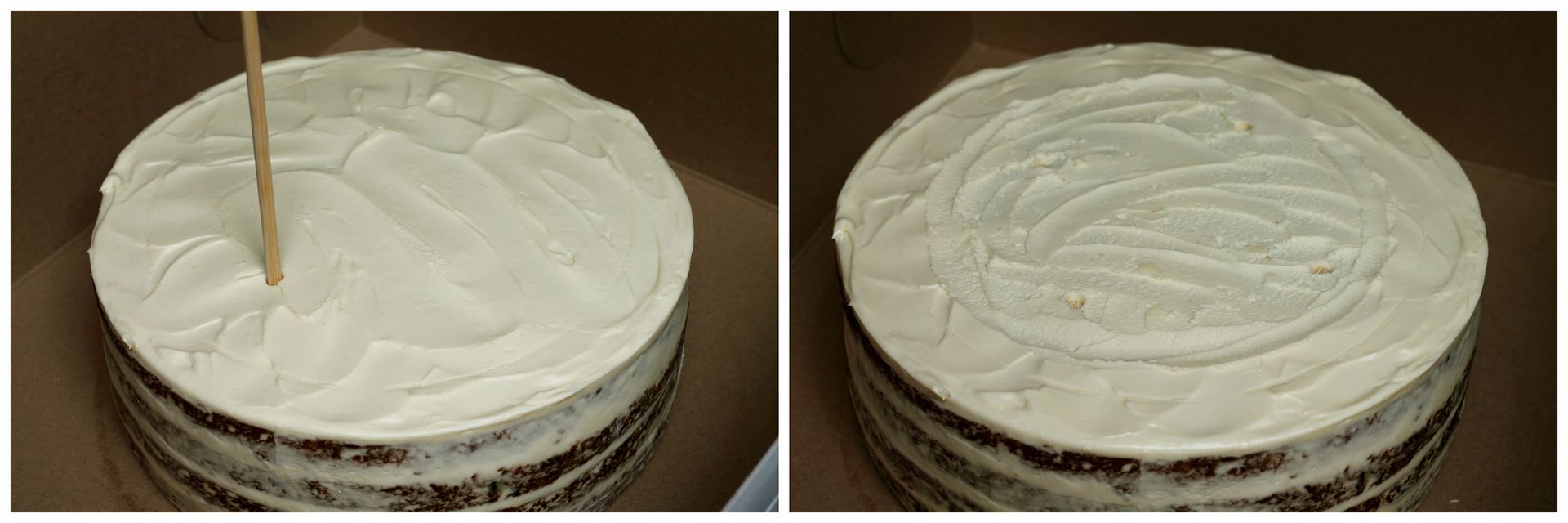
Stack up the cakes and secure with one long barbeque skewer down the centre.
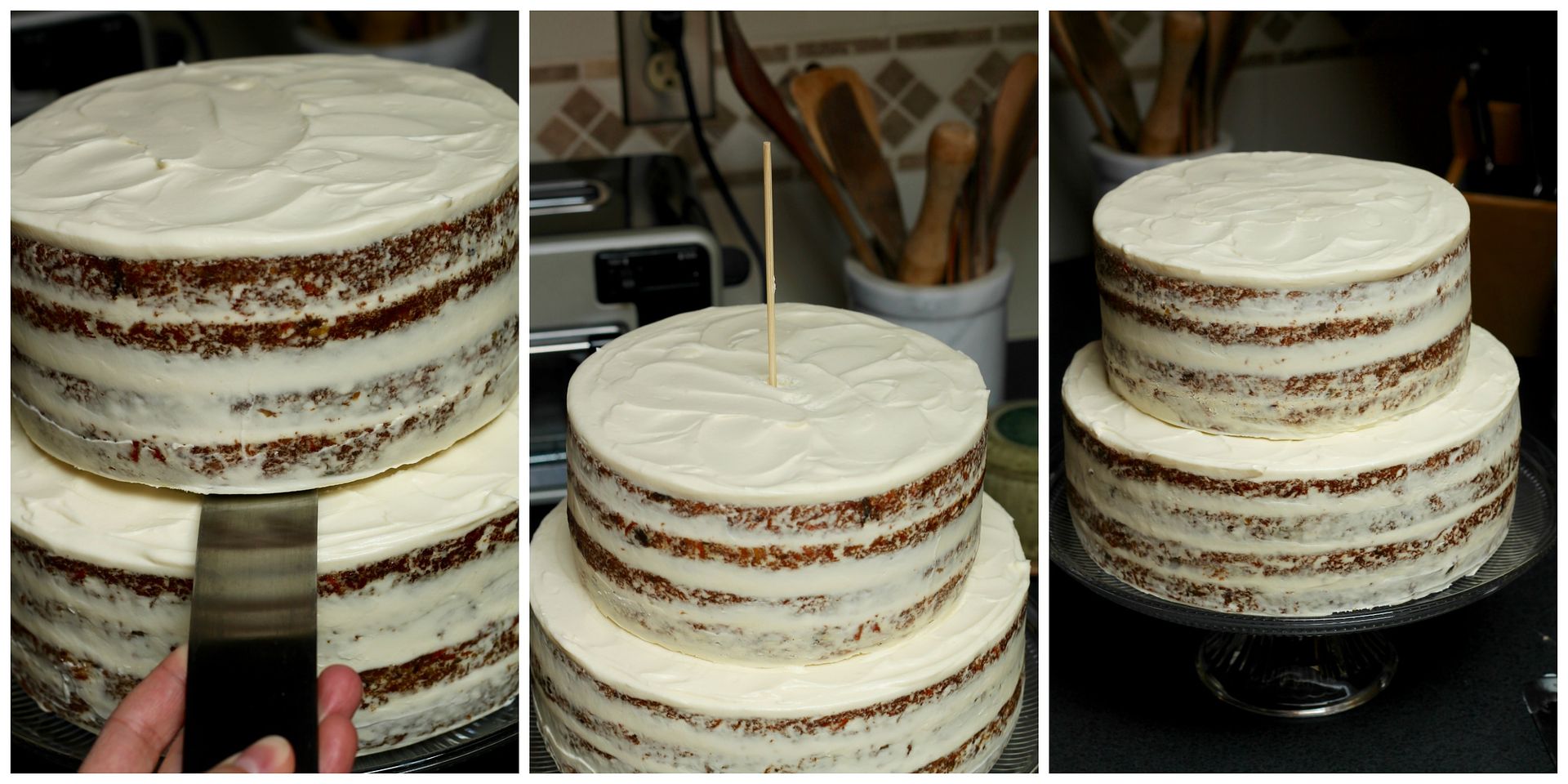
I transported it on my lap to the venue, and decorated it with edible pink, orange, yellow, and red flowers once we got there. The cake sat in a cool corner for several hours during the ceremony and reception and it was just fine for cutting and serving after dinner. 🙂

I remember when you wanted to be Average Spice. 🙂